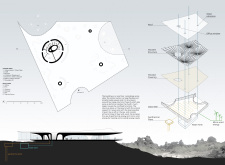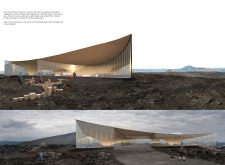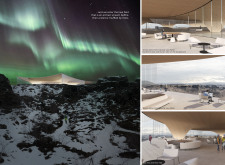5 key facts about this project
The architectural design emphasizes the connection between the built environment and the natural landscape. By referencing the distinct topography of the lava formations, the structure is designed to feel like a natural extension of the site rather than an imposition upon it. This is achieved through the building's strategic layout and use of materials. The extensive use of glass invites panoramic views of the landscape, allowing visitors to experience the area’s natural beauty from within the center. By incorporating large windows, the design fosters a sense of transparency and connection to the outdoors, encouraging visitors to engage with the surrounding scenery.
Wood is a prominent material throughout the project, enhancing the warmth and tactile quality of the visitor experience. The wooden elements serve as both structural and aesthetic components, promoting a sense of belonging and comfort. Concrete is also employed in the design, providing necessary durability while grounding the building in its physical environment. The thoughtful selection of materials underscores a commitment to sustainability, aligning with the center’s mission to promote responsible tourism and environmental stewardship.
The layout of the visitor center effectively organizes space into functional zones. A central reception area serves as the first point of contact for visitors, guiding them through ticketing and introductory information. Adjacent spaces include a café and a children’s play area, which are tailored to enhance visitor comfort and engagement. Staff areas are designed with operational efficiency in mind, ensuring that support functions do not interfere with the visitor experience.
Unique design approaches are evident in several aspects of the project. The incorporation of outdoor terraces is notable, as these areas expand the usable space and foster outdoor interactions. By blurring the lines between interior and exterior spaces, the design encourages visitors to step outside and immerse themselves in the stunning landscape. The flexible design of the central area accommodates various events, educational activities, and exhibitions, highlighting the center’s role as a dynamic space that adapts to the needs of its users.
Geothermal systems are woven into the design, utilizing the area's natural resources for heating and energy, which reinforces the project's commitment to sustainability. This conscious integration of renewable energy aligns with broader environmental goals and reflects a responsible approach to ecological architecture.
This visitor center, situated in the striking Dimmuborgir lava fields, does not only serve as a facility for visitor interaction but also as an educational resource that fosters a deeper understanding of the geological phenomena that characterize this remarkable region. The architecture provides a frame for engaging with the dramatic landscapes of North Iceland while promoting sustainable tourism practices.
Readers interested in exploring more about the project can delve into the architectural plans, sections, and designs to gain further insights into the innovative ideas that define this visitor center. The layers of design and architectural thought reveal a complex relationship between nature and built form, making it a significant contribution to the architectural landscape of Iceland. The integration of the visitor experience with the stunning environment invites a deeper appreciation of the area's geological wonders.


























